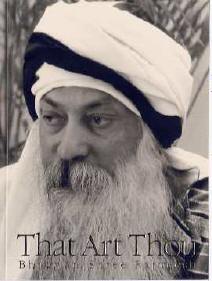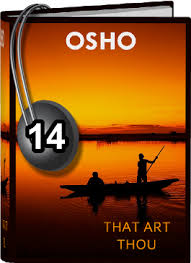Sarvasar Upanishad: Four states of Consciousness
 Een absolute klassieker van Osho is dit boek ‘That Art Thou’.
Een absolute klassieker van Osho is dit boek ‘That Art Thou’.
Het is een serie lezingen tijdens een meditatie camp in de bergen van Navala. In deze vroege meditatie camps nam ook zijn eigen familie deel.
Er was een sfeer van grote intimiteit.
Door adembenemende foto’s word je deelgenoot van Osho’s introductie van de Tratak, een zeer krachtige meditatie.
In witte lungi staat hij daar afgetekend tegen de inktzwarte avond, in het vroeg donkere India.
Het is pure magie en door de krachtige meditatie ook zeer down to earth.
Het boek That Art Thou is een zeldzaamheid. Mogelijk is het tweedehands verkrijgbaar bij de Boekhandel of via internet. Het is er wel als audiobook.
Impressie van That Art Thou
“That Art Thou” is a series of talks given by OSHO at meditation camps on the Upanishads. Individual talks in the series touch on a variety of different topics:
“The Eastern mind divides consciousness into four states. One is when we are awake; the first. The second is dreaming. The third is deep sleep – dreamless; and the fourth is beyond all the three; the turiya, the fourth. “What is this which we call the awake state of consciousness?” Osho
Osho continues:
“Knowledge, knowing is possible in two ways: mediate and immediate. Mediate knowledge means knowledge through some means – not direct, indirect. Senses are the means, the windows through which we know the expansion beyond us but the knowledge gained is indirect, it is not a face to face encounter. The mediator is in-between, the senses are mediators. And when the senses inform something it is not simple information, it is an interpretation also. The senses are not just passive receptors, they are positive interpretators also. They impose something, they add something to the information.
“So whenever anything is reported by the senses to the consciousness, it is not a passive receptivity. The senses have added something to it; they have interpreted it; they have imposed something on it. This imposition creates an illusory world around every consciousness, and everyone begins to live in a world of his own.
“This world, the Eastern esoteric mind says, is maya, illusion. It is not the real, the objective, that which is; it is something that you have created. Everyone is within his own world and there are as many worlds as there are minds. So whenever two persons are near, two worlds are in collision. And otherwise is not possible because you have not known the objective as it is.
“The second dimension, the alternative dimension to know the world as it is, is not through the senses but through transcendence of the senses. And human consciousness can be in a direct encounter; the senses are just dropped and still knowing happens. That knowing is about the truth because there has been no mediator. Now you have known directly. To know the truth through the senses is maya, to know the truth immediately, directly, face to face, is brahman. That which we know remains the same but the knower changes. If he is using the senses then he creates an illusory perception, if he is not using the senses then he is face to face with the reality.
“Meditation is the path how to drop the senses, how to drop the windows and just to be in the reality without anyone in-between.” That Art Thou